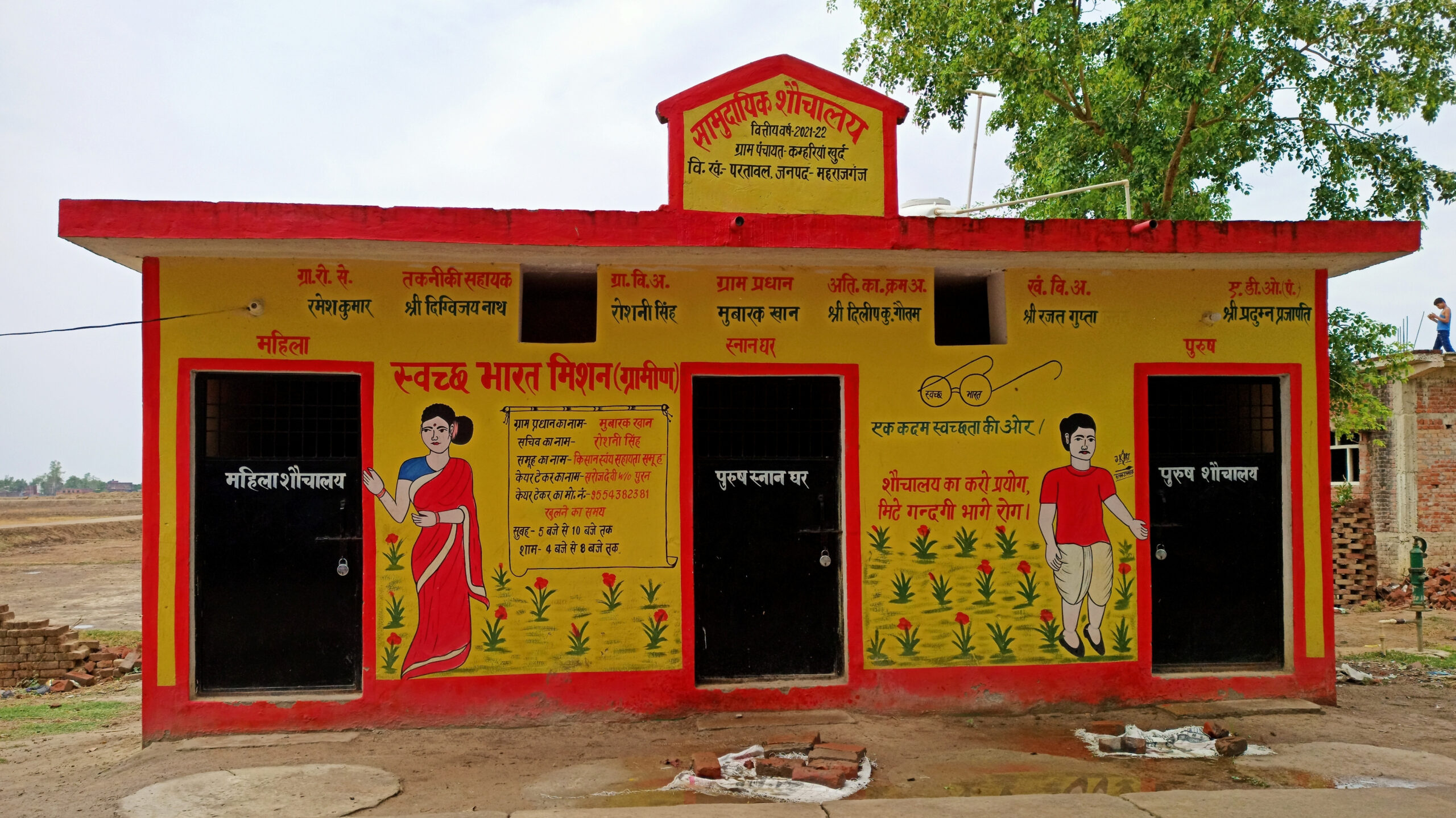In 2014, the Indian government launched the Swachh Bharat (Clean India) Mission (SBM) aimed at improving public sanitation. By 2020, the program had constructed 100 million toilets across the country. In SBM’s first five years, national rates of open defecation fell from 60% to 19% and toilet availability doubled. The program also stressed local community mobilization, following an Information, Education, and Communication approach in which weekly messages via SMS, phone calls and community workers were delivered to rural households with reminders on the importance of safe and hygienic sanitation practices.
In our recent paper published in Nature’s Scientific Reports, we found a clear association in the 2014-2020 time frame between toilet construction under the SBM program and infant and child mortality in India. We estimated that every 10% increase in toilets built through SBM is associated with an estimated reduction of 0.9 infant deaths per 1,000 live births, which scales to 67,235 fewer infant deaths per year given SBM coverage levels across Indian districts.
Our paper, suggesting the efficacy of the SBM program and sanitation programs more generally in potentially reducing infant and child mortality, garnered significant attention in traditional and on social media. On his official X account, Prime Minister Narendra Modi noted the paper’s findings and the importance of access to clean, safe sanitation for improved public health. The broad reach of this paper offers an opportunity to appraise the state of sanitation in India 10 years after the launch of the SBM program. This post outlines key takeaways of the paper and discusses a potential research agenda for sanitation in India and other low- and middle-income countries (LMICs).
Study context
Globally, India accounts for 14% of the 5.4 million deaths among children aged under five. Despite the multicausal nature of infant and child mortality, efforts to reduce these have remained focused on access to health services during the prenatal and postnatal period. In LMICs, other approaches have been more limited, in part due to a comparative lack of evidence on the effectiveness of large-scale public health investments on infant and child mortality, including those relating to sanitation.
Yet lack of or inadequate access to improved sanitation facilities has been linked with poor infant and child health. Proposed pathways driving this link include dehydration and malabsorption of nutrients due to the constant inflammation of the small intestine (environmental enteric dysfunction). Thus, increased access to improved sanitation facilities has potentially significant implications for infant and child mortality.
The study
Our district-level birth cohort model exploited spatial and temporal variation across all Indian districts using data from the 2016 and 2021 rounds of the National Family Health Surveys (NFHS) and government records on toilet construction.
We found a statistically significant inverse relationship between the number of toilets constructed and child mortality, after adjusting for potential confounding variables including household wealth, maternal education, child vaccinations, and access to maternal and child health services, among others. Our results were robust to several placebo, falsification, and robustness checks.
Population-level impact
To contextualize the regression results, we scaled the findings to the population level. Between 2014-2020, approximately 25 million children were born in India annually, and SBM coverage was around 30% across districts. By multiplying the regression coefficient (0.09 per 1,000) by 30, we estimated the reduction of 2.7 infant deaths per 1,000 live births, or 67,235 fewer infant deaths per year. This figure excludes reductions in under-five mortality (U5MR), for which the coefficient was 0.11 per 1,000. If we account for under-five deaths, the estimated overall reduction in child deaths would most likely be larger.
The most substantial reductions in infant mortality rate (IMR) (6.6 fewer deaths per 1,000 live births) were observed in districts where toilet construction exceeded 30% in a year. This finding suggests that large-scale changes in sanitation infrastructure might be a prerequisite to meaningfully reducing IMR.
Our analysis of state-level data also showed that India experienced faster reductions in IMR during the SBM period, compared to previous years, on average across states. This conclusion draws on an analysis of state-year data from 2000–2019 (obtained from NITI Aayog), included in the paper’s supplementary information. (Without considering subnational variation, relying solely on national trends could potentially lead to an incomplete understanding of the impact of SBM on IMR and U5MR.)
Caveats and concerns
Given the complexity of these trends, it’s important to elaborate on what our study shows and does not show. Below are some caveats:
IMR and U5MR are multicausal. It is well-established that improvements in child survival are influenced by a range of factors, including income, access to health care interventions (e.g., vaccines and perinatal care), women’s education, child nutrition, and sanitation. These multisectoral determinants collectively drive reductions in IMR. Therefore, our findings should be interpreted as indicating that sanitation is a contributory factor (an underlying determinant), rather than a sole driver, in improving child survival. Our paper shows that the association between increased toilet construction and IMR was more attenuated in districts with higher coverage of health services (an immediate determinant of child survival) indicating the synergistic role that health services and sanitation interventions might play in reducing mortality.
Data quality. Our study draws on publicly available data sources, primarily NFHS and government records of toilet construction. Although there are concerns about the credibility of government data on toilets built, our results hold even when we use only NFHS data on toilet access. Both NFHS and government sources indicate that toilet coverage increased substantially after 2014.
The unfinished research agenda around sanitation
While the large-scale implementation of the SBM program in India shows promise for the development of similar comprehensive sanitation interventions in other LMICs, unanswered questions remain regarding India’s progress on sanitation. These questions lend themselves to the development of a water, sanitation, and hygiene (WASH) research agenda for India and the larger South Asia region. Below we outline some principal questions and research approaches:
What barriers prevent utilization of constructed toilets? Safely managed sanitation refers to the use of improved facilities that are not shared by multiple households and where excreta are disposed on-site or treated off-site. The WHO/UNICEF Joint Monitoring Programme for Water Supply, Sanitation and Hygiene estimated that in 2020, 71% of households in India had access to safely managed sanitation. Despite the increase in sanitation infrastructure under the SBM program, barriers to practicing safe sanitation remain, including inadequate funding, distrust in government programs, inadequate water supply, and poor maintenance of toilets. Furthermore, historical discriminatory practices related to caste, gender, and religion persist, further creating gaps between construction and utilization of toilets. Existing research documents the effectiveness of small financial incentives and behavior communication change campaigns in increasing toilet use in India. Future research should continue to identify strategies such as community mobilization, financial incentives, and counseling to improve toilet utilization.
What is the state of access to piped water? Improving sanitation facilities not only involves toilet construction, but also ensuring that the waste generated is disposed of safely either on-site or treated off-site. Safe disposal of feces requires access to piped water. Without that, the prevalence of water-borne disease from feces might increase. A study conducted in rural Uttarakhand found that poorly managed drains were associated with higher prevalence of water-borne diseases. Additionally, another study showed that bundling sanitation interventions with access to piped water is more effective in reducing mortality than sanitation interventions alone.
What other interventions can be bundled with sanitation? Comprehensive WASH interventions typically involve the bundling of safe drinking water, improved latrines, and counseling on handwashing and other safe hygiene practices. However, clear evidence from LMICs is lacking on which interventions should be bundled together to ensure maximal impact on child and infant health. A randomized controlled trial (RCT) in Bangladesh found similar impacts on diarrheal incidence and child growth from separate water, sanitation, and hygiene arms compared to a combined water, sanitation, and hygiene arm. As inferences from RCTs offer limited external validity, assessment is required of existing large-scale multisectoral efforts involving WASH and nutrition-sensitive interventions. These assessments will help determine the potential presence or absence of synergistic effects among WASH interventions.
What is the state of municipal waste disposal? Municipal sanitation encompasses the collection, treatment, and disposal of solid and liquid waste, including human excreta. Comprehensive improvements are urgently needed across India in the management of waste services, infrastructure, technology, and public attitudes. Even in major Indian cities, only a small proportion of wastewater is collected by sewage systems, and an even smaller fraction is treated before disposal. Consequently, large amounts of polluted and unsafe sludge are discharged into bodies of water across India, posing significant health risks to both humans and animals.
Does civic infrastructure play a role? Unsanitary open drains serve as key transmission pathways for waterborne diseases. Additionally, potholes and broken pedestrian infrastructure lead to water stagnation, becoming breeding grounds for disease vectors. Finally, the failure to provide accessible trash cans across cities, towns, and villages promotes the practice of littering, a major source of pollution.
What is the state of sanitation infrastructure in urban areas? While access to toilets is higher in urban areas than in rural areas, the challenges of poor maintenance of toilets, unsafe disposal of waste, and unmanaged septage are at times also more prevalent in urban communities, where the resulting health and environmental consequences might be more severe than in rural areas because of higher space constraints and population density. Approximately two thirds of the population of India’s largest megacity, Mumbai, reside in urban slums. Yet programs and research agendas in LMICs typically focus on rural sanitation. With populations in LMICs becoming increasingly urbanized, it is pertinent that programs and research agendas include urban communities.
Are there subnational and national success stories that we can learn from? Despite the considerable challenges, there are notable sanitation success stories in India that can serve as models for other regions. Indore, known as the country’s cleanest city, exemplifies this. Indore implemented six categories of waste segregation, established a control command center to closely monitor the movement of garbage collection vehicles to processing centers, launched campaigns to shift public attitudes towards sanitation, and employed a large team of female sanitation workers equipped with protective gear like gumboots and masks. These examples demonstrate that implementation of effective multisectoral sanitation interventions is achievable with the right political and administrative will.
What data sources are available to study sanitation comprehensively in India and globally? While Demographic Health Surveys in LMICs and government dashboards provide some sanitation data, the relevant modules are limited in scope. There is a need to expand these surveys with comprehensive modules that capture observational data on sources of pollution across communities and actual utilization of toilet facilities. Additionally, in the age of artificial intelligence, platforms like Google Maps Street View can be leveraged to gather observational data on terrestrial sanitation across geographies in all LMICs. Donor investments are crucial to support the collection of such data, making it freely accessible to the public and the research community at large. Moreover, qualitative data capturing experiences of populations accessing and utilizing sanitation interventions is required to identify barriers, and facilitators are needed to guide the take-up of sanitation interventions—especially among traditionally marginalized communities.
What are future challenges that sanitation programs can anticipate? Communities in LMICs are increasingly becoming more vulnerable to disruptions caused by climate change—which also pose a threat to the implementation of WASH interventions. For instance, increased flooding and droughts might limit access to safe and hygienic sanitation facilities and reduce availability of water in sewer systems. Furthermore, sanitation facilities can contribute to greenhouse gas emissions depending on the choice of wastewater treatment systems and efficiency of water pumps used. It is critical that research agendas on sanitation in LMICs incorporate ways to make safe sanitation interventions adaptable to unpredictable climates and accessible to vulnerable communities in resource-poor and conflict-prone settings.
Suman Chakrabarti is an Associate Research Fellow with IFPRI’s Nutrition, Diets, and Health (NDH) Unit based in New Delhi; Soyra Gune is a NDH Research Analyst based in New Delhi; Tim A. Brucker is a professor in the Department of Health, Society, and Behavior in the Joe C. Wen School of Population and Public Health at UC Irvine; Julie Strominger is associated with the Division of Epidemiology in the College of Public Health at Ohio State University; Parvati Singh is an Assistant Professor in the Division of Epidemiology in the College of Public Health at Ohio State University. Opinions are the authors’.
Funding: None of the authors involved in this study received funding from the Government of India, nor are they affiliated with the government in any capacity. This research was an independent effort of all the authors stemming from interest in the program.
Referenced paper:
Chakrabarti, Suman; Gune, Soyra; Bruckner, Tim A.; Strominger, Julie; and Singh, Parvati. 2024. Toilet construction under the Swachh Bharat Mission and infant mortality in India. Scientific Reports 14(2024): 20340. https://doi.org/10.1038/s41598-024-71268-8







